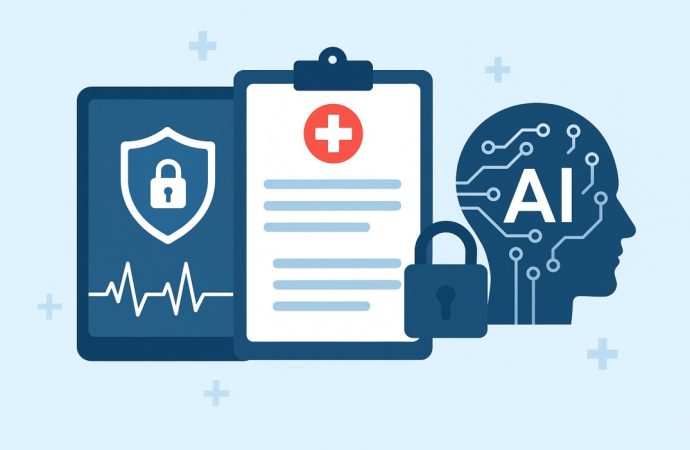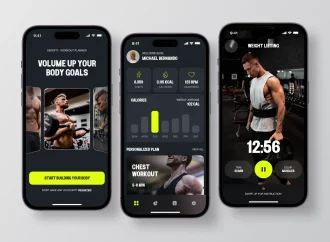Introduction The healthcare industry is undergoing a massive transformation powered by technology and artificial intelligence (AI). From predictive analytics that anticipate disease outbreaks to diagnostic tools that detect anomalies faster than ever, AI has become a driving force in improving care quality and operational efficiency. However, with this innovation comes a major responsibility protecting sensitive
Introduction
The healthcare industry is undergoing a massive transformation powered by technology and artificial intelligence (AI). From predictive analytics that anticipate disease outbreaks to diagnostic tools that detect anomalies faster than ever, AI has become a driving force in improving care quality and operational efficiency. However, with this innovation comes a major responsibility protecting sensitive patient data.
Building secure and intelligent healthcare applications requires developers to find the perfect balance between innovation and compliance. With data privacy laws like HIPAA (Health Insurance Portability and Accountability Act) setting strict standards for handling patient information, healthcare organizations can’t afford to compromise security. Choosing the right programming language can make all the difference and Golang, also known as Go, stands out as one of the most reliable and efficient technologies to achieve both AI excellence and regulatory compliance.
What Is HIPAA and Why Is Compliance Important?
HIPAA stands for the Health Insurance Portability and Accountability Act. It is a US law that sets standards for protecting patient health information. Any app or software that stores, processes, or transmits patient data must follow HIPAA rules. This includes ensuring privacy, securing data, and controlling access to information.
Non-compliance can lead to heavy fines and loss of trust. Therefore, healthcare apps must be designed with strong security, encryption, and monitoring. Choosing the right technology is key to meeting these strict standards.
What Makes Golang Special?
Golang is a modern programming language known for its speed, simplicity, and strong support for concurrent programming. It was developed by Google in 2007 to address problems faced by other languages. Golang has many features that make it a great choice for healthcare apps:
- Fast Performance: Golang compiles directly into machine code, so apps run very quickly. This is important for healthcare apps where speed can affect user experience and even patient care.
- Simple and Clear Syntax: Golang’s clean and easy-to-read code reduces bugs and makes it easier to maintain and audit, which is crucial for security.
- Strong Security Features: Golang supports built-in encryption libraries and secure network communication, helping protect sensitive data.
- Built-in Concurrency: Healthcare apps often need to handle many tasks at once. Golang’s goroutines allow apps to manage multiple operations smoothly and efficiently.
- Scalable: Golang can handle large numbers of users and high data volumes, which is important for growing healthcare systems.
The Expanding Role of AI in Healthcare
Artificial intelligence is no longer a futuristic concept in healthcare; it’s a necessity. Hospitals and health-tech companies now rely on AI for early disease detection, treatment planning, patient data analysis, and even administrative tasks like billing and scheduling. AI-driven insights are helping doctors make faster and more accurate decisions, ultimately saving lives.
However, behind these innovations lies an enormous amount of data that must be processed securely and efficiently. That’s where Go excels. Developers increasingly use Golang for AI because of its unmatched performance, simplicity, and concurrency capabilities.
Golang enables multiple processes to run simultaneously using goroutines, making it ideal for real-time data analysis — a key requirement in healthcare AI. Whether it’s processing thousands of patient scans or running deep learning models that predict patient outcomes, Go ensures speed, stability, and scalability without overloading system resources.
Moreover, its built-in memory management and error handling prevent crashes that could disrupt critical healthcare operations. This reliability gives AI developers the freedom to innovate confidently while maintaining consistent uptime, a non-negotiable factor in healthcare environments.
Understanding HIPAA-Compliant App Development
While AI improves efficiency and accuracy, HIPAA ensures patient data remains protected. Every app that handles Protected Health Information (PHI) including medical records, diagnostics, and treatment histories must adhere to HIPAA regulations. Non-compliance not only leads to heavy fines but also erodes patient trust.
To build healthcare apps that meet legal and ethical standards, developers must prioritize HIPAA-compliant app development practices from day one. This means implementing:
- End-to-End Encryption: All PHI must be encrypted both at rest and in transit.
- Access Controls: Only authorized users should be able to view or modify patient data.
- Audit Logs: Every access, edit, or download must be logged and monitored.
- Data Backup and Recovery: Systems must be able to restore data quickly after incidents.
- Secure APIs and Hosting: Cloud infrastructure and APIs must meet HIPAA standards.
When these elements are paired with the efficiency and security features of Golang, developers can create healthcare solutions that not only comply with HIPAA but also perform exceptionally well under real-world workloads.
Why Golang Excels in Building HIPAA-Compliant AI Healthcare Apps
- High Performance for Real-Time Data Processing: AI-powered healthcare apps deal with large volumes of data from multiple sources wearables, lab systems, and electronic health records. Go’s compiled nature delivers faster execution and lower latency, which are crucial for real-time medical decision-making.
- Concurrency and Scalability: Golang’s lightweight concurrency model allows parallel data processing, making it ideal for AI algorithms and machine learning models that handle simultaneous computations across multiple patients or datasets.
- Built-in Security Features: Go reduces dependency vulnerabilities with its minimalistic library set and strict type safety. Developers can easily integrate security layers, reducing risks of data breaches a key requirement in HIPAA-compliant systems.
- Seamless Integration with Cloud Infrastructure: Modern healthcare apps often rely on secure cloud environments like AWS, Google Cloud, or Azure. Go works seamlessly with these platforms, enabling encrypted data transfers, containerized deployments, and microservices architecture.
- Developer Productivity and Maintenance: Go’s simple syntax reduces complexity, allowing teams to develop, test, and maintain large healthcare systems faster. Its built-in testing frameworks ensure each component from AI logic to HIPAA controls performs flawlessly.
The Synergy Between AI Innovation and Compliance
AI and compliance might seem like two opposing forces one focused on innovation and speed, the other on regulation and control. Yet, the most successful healthcare applications find harmony between the two.
By using Golang, developers can merge intelligence and compliance effortlessly. Go’s speed and efficiency empower AI-driven analytics, while its security and stability align perfectly with HIPAA’s strict requirements. For example, an AI-based telemedicine platform can process live video consultations, analyze speech patterns for medical insights, and store patient records securely all in real time with Go as the foundation.
This synergy ensures healthcare providers don’t have to choose between innovation and compliance; they can achieve both simultaneously.
Preparing for the Future of AI and Healthcare Compliance
The future of healthcare lies in intelligent systems that can think, predict, and act all while maintaining absolute data privacy. As regulatory landscapes evolve and the use of AI expands, Golang will continue to be a preferred language for developers building compliant, high-performance solutions.
Its versatility extends beyond AI; it’s equally effective for APIs, cloud-native healthcare systems, and data integration platforms. Developers can rely on Go to future-proof their applications ensuring compliance, performance, and scalability remain strong as technologies advance.
Challenges and Considerations
While Golang is excellent for HIPAA apps, developers should be aware of some challenges:
- The language is still growing, so some specialized libraries may not be as mature.
- Developers need to learn Golang’s specific way of handling errors and concurrency.
- Building complex user interfaces usually requires combining Golang with other tools or frameworks.
Despite this, the benefits of Golang’s performance and security often outweigh these challenges.
The Future of Golang in Healthcare
As healthcare technology evolves, Golang is likely to play an even bigger role. Its speed, security, and ease of use make it ideal for new trends like AI-powered diagnostics, remote patient monitoring, and big data analytics. Healthcare providers and developers who adopt Golang now will be better prepared for the future.
Conclusion
The healthcare industry demands innovation without compromise. Golang makes it possible to build powerful AI applications that respect the privacy, security, and compliance standards required by HIPAA. Its combination of speed, reliability, and security provides developers with the perfect toolkit for the next generation of healthcare solutions.
By leveraging Golang for AI and applying the principles of HIPAA-compliant app development, healthcare organizations can create systems that are intelligent, secure, and built to last. As digital health continues to expand, the partnership between AI and compliance powered by Golang will set the standard for innovation in medical technology.
For teams looking to accelerate development with the right expertise, exploring experienced AI app developers can make all the difference in bringing compliant, high-performance healthcare innovations to life.






















